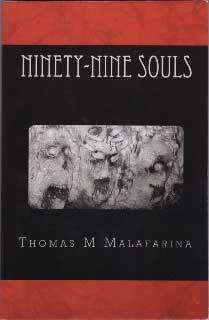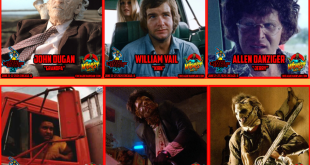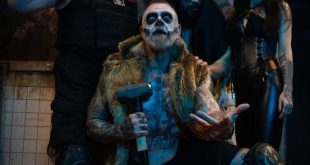
Ninety-Nine Souls is Thomas M. Malafarina’s first novel purchased by Sunbury Press this past summer in a publishing trifecta that also included a collection of short stories, Thirteen Nasty Endings, and a second novel which I reviewed here on its debut in September, Burn Phone … in an email to me Tom stated that he had originally intended this novel to be a screenplay, but when he was told that he writes with too much detail for the form he decided to expand the story into a book – and you can tell. Not that that is a bad thing in and of itself; what I mean to say is that the book at times reads like a screenplay, which is wonderful and dramatic during the intense scenes of very horrific action but rather clumsy and awkward in translation during the more transitional moments, especially noticeable in an otherwise wonderful, dramatic mis-en-scene towards the opening of the book that takes place in a local restaurant “frequented by townsfolk who knew each other and each other’s business for decades”. But I’m getting ahead of myself.
The novel is set in 1965 Ashton, Pennsylvania, within the author’s native Schuylkill County – it is a tough, proud mining community which Malafarina paints with obvious affection and yet corrupted beauty, using the natural environment as one of the many metaphoric threads forwarding the notion that it is very difficult to remain clean while trying to survive in these foothills. In fact, one of the best qualities of the novel – aside from Malafarina’s superb visceral set pieces – is how well the author allows us to get a feel for this mining community, its people and the conundrums and sacrifices that surround their daily lives in such short order, which is especially relevant (and poignant) in light of the recent worldwide mining disasters. I daresay that he has the same sense of place as King does with his beloved Maine:
“Dusk fell upon an overcast summer day in late August 1965 like a dark grey cloak of despair. A disquieting autumn breeze chilled the air, forewarning the inescapable approach of another cold winter. In the distance, black silt-covered hills cleaved the earth stretching westward through the barren coalfields of Schuylkill County, Pennsylvania. Elsewhere, the world was going through one of the greatest cultural revolutions in its history, but here time seemed to stand still.”
Or: “… a typical late summer morning in nearby Ashton, Pennsylvania. The sun rose high in the sky and its light reflected off the coal dust covered hillsides. Small scrub trees attempted to grow along the banks of the hills making for an unusual contrast to the stark black appearance. Birds somehow managed to nest in these scrub trees and could be seen flying bush to bush in search of food.”
But this is no travelogue. This is a horror novel … and one that opens with yet another great sequence of violence and unapologetic gore that Malafarina will become known for in time (I’m sure of it): a group of six boys trudge up to the abandoned Coogan Mine intent on seeing the smallest of them make good on a dare that he would enter “Devil Dan’s” lair, named after a legend perpetuated across generations from the time that the mine had been closed. There had been a disastrous collapse in 1885 and three men had been trapped behind tons of rock; one of them, Danny O’Boyle, a tough Irish immigrant, in the throes of despair and facing certain death, renounced his faith and swore a pact with the Devil for deliverance so that he may have his revenge on the Coogan family and it’s heirs … and the legend tells of how he had indeed been saved by Satan, had been hideously transformed by him into a soul-feeding demon and then held captive a mile below the surface until he harvests ninety-nine souls (I won’t ruin it for you since the “story of the legend” takes up the entire second act of the book).
Well, the little guy backs down and in the ensuing tough guy banter amongst the kids Billy Coogan (an heir to the Coogan family fortune) and his lackey Jimmy McKinley are strong armed into entering the mine in order to save some face. What follows is an unforgiving onslaught of violent mayhem that Clive Barker himself would be proud of and which takes 5 pages to complete! Here’s a taste:
“ … Jimmy’s body jerked as if pulled by some unknown force inside the mine, slamming the right side of his body and face against the broken door, shattering his nose and breaking out several of his front teeth. Blood spurted from his crushed face yet he did not shout or scream. The young boy’s ruined face held a look of complete shock and disbelief. The flesh on the right side of his face was completely gone, hanging in shredded chunks from the rough wood on the door. Blood gushed from his mouth and smashed nose. As he realized what was happening to him, his expression changed from disorientation to pain and then to utter terror.”
The legend and monster themselves are nothing that horror fans won’t recognize but what sets Malafarina apart from most is the delirious, vicious pleasure he seems to take in wielding such generic genre conventions all done with an artist’s eye for detail and tone and color and movement (he has a book of “dark” cartoons to be published by Sunbury Press in the future, natch). As he continues to examine (at least in this book and in Burn Phone) the nature of selling one’s own soul and the evil that men will do in order to get “what’s coming to them”, it is clear that the portrait he is intent on revealing is one wherein man has become the object of his own anger – that man possesses the capability of becoming monstrous and in the end is ultimately corrupted. It is a theme that is not new, of course, but it is certainly given a fresh spin and is somehow not at all trite in Malafarina’s hands.
Danny O’Boyle asks: “What have you done to me?”
Satan replies: “Done to you? I have done nothing to you. I have done everything for you.”
What is noteworthy about the legend in Ninety-Nine Souls, though, is that Malafarina takes advantage of it to reflect the idea that though it is easy to become cynical, amused and even bored with the small town happenings in this country we all know in our deepest selves that we’ve been there – that no matter how coiffed and educated (“civilized”) we fancy ourselves to be we recognize deep down that but for the grace of God go ourselves, that but for the happenstance of our birthright, our locations or just plain luck we are not in a position where just plain bad luck, or an accident, can end our dreams of “getting out”. The feeling of being trapped and powerless and the need to “do what you need to do to survive” is an ageless design in the patchwork quilt that is the American identity.
Before I close I just want to mention the design of the novel, something to which I alluded to in the opening paragraph. It is an interesting construct, broken into thirds: the first act deals with the opening attack of the children at the mine and then the reaction of the townspeople at Maggie’s Restaurant; the restaurant scene has some wonderful dialogue and interplay amongst the folks at various tables and is another example of Malafarina’s adeptness with conversation (you might remember me mentioning the fantastic job he did with some very menacing dramatic dialogue scenes in my review of Burn Phone). Then we have the revelation of the “story behind the legend” as told by the heir of the man who discovered the 3 trapped bodies after the original mine collapse, which takes up the entire second act and is told through the device of an interview with a television journalist. And then the third act concerns the final revelations and culmination of the corruption centered on the mine. Overall, the book is a bit disjointed and uneven as a result and due to the fact, I think, that this was originally a screenplay that was subsequently “turned” into a novel.
Ninety-Nine Souls is a terrific first novel, though, and a promising debut; it’s about small town conspiracies and the sins of our fathers, greed and corruption, supply and demand and the angst that accompanies them … and eventual comeuppance. It just so happens to be a very sinister horror novel as well.
I hope that Tom Malafarina will continue to write more novels that explore the existential, Lovecraftian horrors and philosophies of Burn Phone and the morality play that is Ninety-Nine Souls – I think that he is a diamond in the rough and someone definitely to watch … there’s a big, raucous, balls-to-the-wall terrifying book in him somewhere and I for one cannot wait to read it!
Treat yourself this Halloween weekend and purchase a copy of the book from Sunbury Press (you’ll be glad that you scored this up-and-coming writer’s first book – first edition, too).
“Ninety-Nine Souls” by Thomas M. Malafarina ~ http://www.tommalafarina.com/Author.html ~ ISBN 978-1453653715 ~ Trade Paper 156 pages ~ Suggested Retail $14.95 ~ © 2010 Sunbury Press, Camp Hill, PA ~
“Ninety-Nine Souls” @ Sunbury Press: http://004004c.netsolhost.com/99souls.html
 Horror News | HNN Official Site | Horror Movies,Trailers, Reviews
Horror News | HNN Official Site | Horror Movies,Trailers, Reviews





